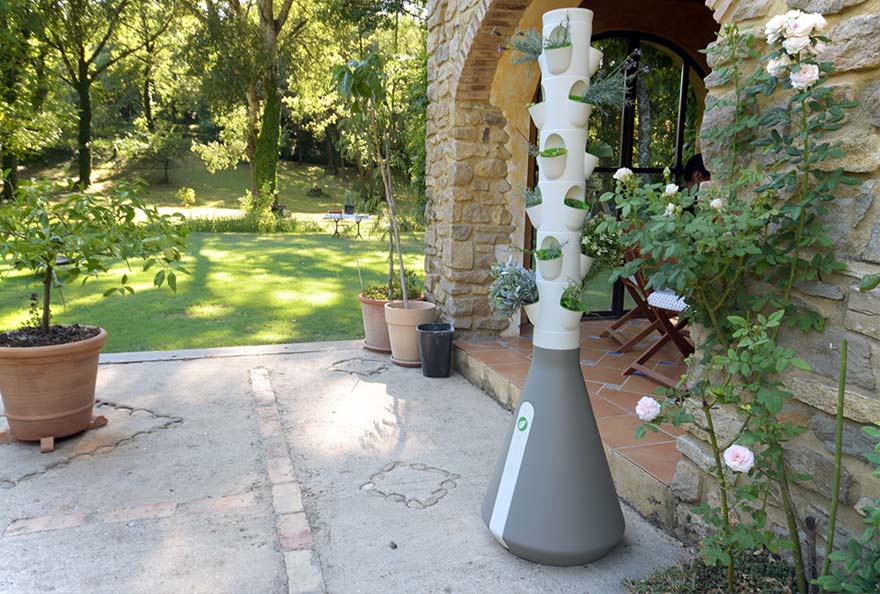Not everyone is lucky enough to live in the country and grow a vegetable garden. Home Vegetable Garden offers vertical, connected and playful urban vegetable garden kits for individuals. An ancestral practice of soil-less cultivation used by the Incas, brought back to the taste of the 21st century. A solution to feed the planet?
L’access to fresh produce is a fundamental right. So, how do you access healthy and natural food when you live in the city? To democratize urban agriculture, just like access to water, we must make it simple, fun and accessible to all. It is from this observation that Frédéric Brece, an engineer by training, a fan of new technologies and passionate about the world of cooking, decided to tackle the challenges of urban culture to help, first of all, friends grow a vegetable garden on their balcony.
Indeed, it was while observing friends who were struggling to grow tomatoes on their balconies that he realized that it is difficult to grow one's own vegetables in the city at home. The solutions that do exist are often based on the practices of rural culture and are therefore unsuitable for urban use.
To help his friends, he turned to modern technologies of above-ground cultivation (hydroponics) for the yield aspect (space and production) and of connected objects to make the experience simpler and more fun. From there was born HomePotager.
Soil-less cultivation (or hydroponics: from the Greek "Hydro = water" and "ponos = work") is a crop in which the plant roots rest in a reconstituted medium detached from the soil and uses water and light. The process is not new since, although it is not really hydroponics, the idea of natural off-ground cultivation appears with the hanging gardens of Babylon. The peoples living on the shores of lakes in the high mountains of Peru, such as Titicaca, cultivated their vegetable gardens on the surface of the water. The Aztecs, for their part, settled in the swamps near the future city of Mexico and designed rafts made of rushes and reeds covered with a layer of silt called chinampa on which the farmers planted; it is still possible to see them today. The roots of the plants plunged into the water of the lakes: without knowing it, they were the precursors of a primitive aquaculture species. The Chinese still employ age-old techniques of gravel cultivation.
Around 1400, the Incas used agricultural production techniques directly on large slabs of granite without soil and managed to feed a large population with very little water. A technique used for centuries and discovered by the conquistadors 500 years ago.
The above-ground culture we know today was born in 19th century Germany. It was discovered through research to find out what plants were eating. It wasn't until 1930 that the German officer Walter Gericke produced the first commercial hydroponic system in the United States. During World War II, Americans grew hydroponic vegetables in the volcanic islands of the Pacific to provide the vitamin needed to keep their troops in garrison there healthy. (1).
The innovation of the Home Vegetable Garden comes from a technology that is there to serve the user because it acts as a personal assistant that guides him/her through all the stages of cultivation, so that each individual can easily access what he/she needs in fresh and natural fruit and vegetables while respecting the environment.

HomePotager therefore wants to democratize access to fresh and natural fruits and vegetables either by producing them yourself or by using the community's available resources. Indeed, HomePotager is a means to create or strengthen social links between children/parents or between neighbours, an educational tool to teach our children the cycle of life, patience and respect for the environment. Eco-responsible and social value propositions are a response to the CSR program of companies. A practice based on plants also enables companies to implement well-being at work, create new relationships between individuals by breaking down hierarchical barriers, bring comfort to employees, and enhance the value of collaborative actions.
How does it work?
Home Vegetable Garden is connected to a free 100% smartphone application that allows you to receive instructions for watering or adding nutrients to your plants. Acting as a personal garden coach, the application will accompany you throughout the life of your plants. No more leaves that turn yellow because you have been too generous with water. The application will tell you what to pour and will alert you when your plants are too hungry and thirsty.
The application also allows you to geolocate other Home Potager users in your neighborhood to exchange your crops, experiences or recipes. You can thus have access to fresh and natural fruits and vegetables all year round and in an unlimited way thanks to the community.

Up to 18 plants can be placed in the small receptacles and up to 20 kilos of harvest can be obtained. Simply follow the application to replenish water and nutrients until you harvest fresh, natural fruits and vegetables. It's ergonomic, simple and fun.
And why not consider Home Vegetable Garden as a solution to the food needs of an ever-growing world population? The stakes are high when we know that the number of inhabitants could exceed 12 billion by 2050 ...
Next step: finalize their campaign for crowdfunding on Ulule for a first marketing this summer (Sales price: 690 € TTC).
Online sale : www.homepotager.fr

(1) Source Wikipedia












